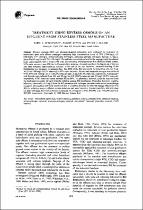JavaScript is disabled for your browser. Some features of this site may not work without it.
- ResearchSpace
- →
- Research Publications/Outputs
- →
- Journal Articles
- →
- View Item
| dc.contributor.author |
Schoeman, JJ

|
en_US |
| dc.contributor.author |
Steyn, A

|
en_US |
| dc.contributor.author |
Scurr, PJ

|
en_US |
| dc.date.accessioned | 2007-02-08T07:49:27Z | en_US |
| dc.date.accessioned | 2007-06-07T10:03:47Z | |
| dc.date.available | 2007-02-08T07:49:27Z | en_US |
| dc.date.available | 2007-06-07T10:03:47Z | |
| dc.date.copyright | en_US | |
| dc.date.issued | 1996-09 | en_US |
| dc.identifier.citation | Schoeman, JJ, Steyn, A and Scurr, PJ. 1996. Treatment using reverse osmosis of an effluent from stainless steel manufacture. Water Research, vol 30(9), pp 1979-1984 | en_US |
| dc.identifier.issn | 0043-1354 | en_US |
| dc.identifier.uri | http://hdl.handle.net/10204/1651 | en_US |
| dc.identifier.uri | http://hdl.handle.net/10204/1651 | |
| dc.description.abstract | Reverse osmosis (RO) and physical/chemical technology were evaluated for treatment of neutralized spent acid effluent (seepage) containing high concentration levels of TDS (7500mg/l), Ca (400 mg/l), Cr-V1 (42 mg/l), nitrate-nitrogen (827 mg/l), ammonia-nitrogen (33 mg/l), fluoride (13 mg/l), phenolics (45 mg/l) and COD (620 mg/l). The calcium concentration level in the seepage could be reduced from approximately 400 to 5 mg/l with soda ash softening. Initial permeate flux (feed and bleed system, 85% water recovery) was 278 l/m (2).d. Permeate flux, however, dropped rapidly in the beginning of the run and then remained approximately constant to the end of the run. However, chemical cleaning of the membranes was necessary to maintain flux. The TDS of the RO feed could be reduced in one case from 34,253 to 1560 mg/l (95.5% removal) at 85% water recovery. Nitrate and ammonia nitrogen were reduced from 2691 and 103 mg/l to 414 (84.6% removal) and 15 mg/l (85.3% removal), respectively. Chromium (V1) and fluoride were reduced from 183 and 90 mg/l to 0.38 (99.8% removal) and 2.8 mg/l (96.9% removal), respectively. COD removals varied between 60 and 80%. No phenolics, however, could be removed from the feed (approximately 32 mg/l) with the cellulose acetate RO membranes. Phenolics, however, could be effectively removed (<.0.2 mg/l) from the RO permeate with hydrogen peroxide oxidation or ion-exchange treatment. Preliminary test work has shown that it should be possible to treat the seepage effectively with RO for pollution control, effluent volume reduction and water recovery. | en_US |
| dc.format.extent | 587729 bytes | en_US |
| dc.format.mimetype | application/pdf | en_US |
| dc.language.iso | en | en_US |
| dc.publisher | Pergamon-Elsevier Science Ltd | en_US |
| dc.rights | Copyright: 1996 Pergamon-Elsevier Science Ltd | en_US |
| dc.source | en_US | |
| dc.subject | Neutralized spent acid | en_US |
| dc.subject | Reverse osmosis | en_US |
| dc.subject | Ammonia-nitrogen removal | en_US |
| dc.subject | Acid effluents | en_US |
| dc.subject | Industrial seepage | en_US |
| dc.subject | Pollution control | en_US |
| dc.subject | Environmental engineering | en_US |
| dc.title | Treatment using reverse osmosis of an effluent from stainless steel manufacture | en_US |
| dc.type | Article | en_US |
| dc.identifier.apacitation | Schoeman, J., Steyn, A., & Scurr, P. (1996). Treatment using reverse osmosis of an effluent from stainless steel manufacture. http://hdl.handle.net/10204/1651 | en_ZA |
| dc.identifier.chicagocitation | Schoeman, JJ, A Steyn, and PJ Scurr "Treatment using reverse osmosis of an effluent from stainless steel manufacture." (1996) http://hdl.handle.net/10204/1651 | en_ZA |
| dc.identifier.vancouvercitation | Schoeman J, Steyn A, Scurr P. Treatment using reverse osmosis of an effluent from stainless steel manufacture. 1996; http://hdl.handle.net/10204/1651. | en_ZA |
| dc.identifier.ris | TY - Article AU - Schoeman, JJ AU - Steyn, A AU - Scurr, PJ AB - Reverse osmosis (RO) and physical/chemical technology were evaluated for treatment of neutralized spent acid effluent (seepage) containing high concentration levels of TDS (7500mg/l), Ca (400 mg/l), Cr-V1 (42 mg/l), nitrate-nitrogen (827 mg/l), ammonia-nitrogen (33 mg/l), fluoride (13 mg/l), phenolics (45 mg/l) and COD (620 mg/l). The calcium concentration level in the seepage could be reduced from approximately 400 to 5 mg/l with soda ash softening. Initial permeate flux (feed and bleed system, 85% water recovery) was 278 l/m (2).d. Permeate flux, however, dropped rapidly in the beginning of the run and then remained approximately constant to the end of the run. However, chemical cleaning of the membranes was necessary to maintain flux. The TDS of the RO feed could be reduced in one case from 34,253 to 1560 mg/l (95.5% removal) at 85% water recovery. Nitrate and ammonia nitrogen were reduced from 2691 and 103 mg/l to 414 (84.6% removal) and 15 mg/l (85.3% removal), respectively. Chromium (V1) and fluoride were reduced from 183 and 90 mg/l to 0.38 (99.8% removal) and 2.8 mg/l (96.9% removal), respectively. COD removals varied between 60 and 80%. No phenolics, however, could be removed from the feed (approximately 32 mg/l) with the cellulose acetate RO membranes. Phenolics, however, could be effectively removed (<.0.2 mg/l) from the RO permeate with hydrogen peroxide oxidation or ion-exchange treatment. Preliminary test work has shown that it should be possible to treat the seepage effectively with RO for pollution control, effluent volume reduction and water recovery. DA - 1996-09 DB - ResearchSpace DP - CSIR KW - Neutralized spent acid KW - Reverse osmosis KW - Ammonia-nitrogen removal KW - Acid effluents KW - Industrial seepage KW - Pollution control KW - Environmental engineering LK - https://researchspace.csir.co.za PY - 1996 SM - 0043-1354 T1 - Treatment using reverse osmosis of an effluent from stainless steel manufacture TI - Treatment using reverse osmosis of an effluent from stainless steel manufacture UR - http://hdl.handle.net/10204/1651 ER - | en_ZA |






